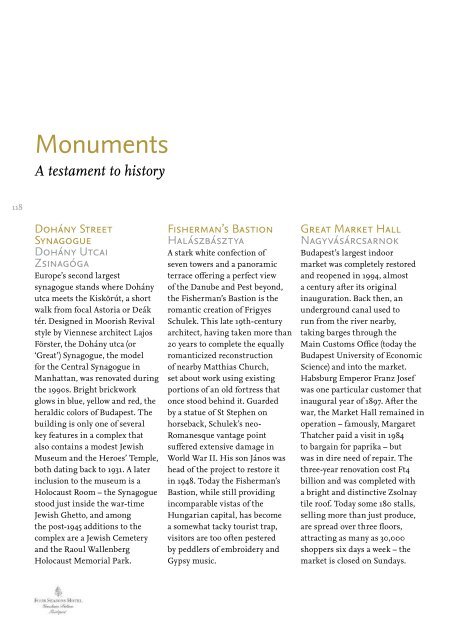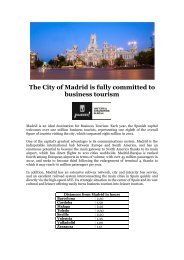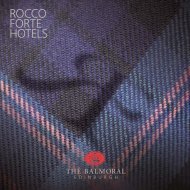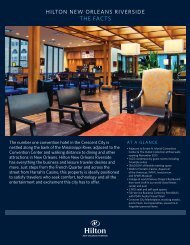Through Four Seasons' Eyes Budapest - IMEX America
Through Four Seasons' Eyes Budapest - IMEX America
Through Four Seasons' Eyes Budapest - IMEX America
You also want an ePaper? Increase the reach of your titles
YUMPU automatically turns print PDFs into web optimized ePapers that Google loves.
Monuments<br />
A testament to history<br />
118<br />
Dohány Street<br />
Synagogue<br />
Dohány Utcai<br />
Zsinagóga<br />
Europe’s second largest<br />
synagogue stands where Dohány<br />
utca meets the Kiskörút, a short<br />
walk from focal Astoria or Deák<br />
tér. Designed in Moorish Revival<br />
style by Viennese architect Lajos<br />
Förster, the Dohány utca (or<br />
‘Great’) Synagogue, the model<br />
for the Central Synagogue in<br />
Manhattan, was renovated during<br />
the 1990s. Bright brickwork<br />
glows in blue, yellow and red, the<br />
heraldic colors of <strong>Budapest</strong>. The<br />
building is only one of several<br />
key features in a complex that<br />
also contains a modest Jewish<br />
Museum and the Heroes’ Temple,<br />
both dating back to 1931. A later<br />
inclusion to the museum is a<br />
Holocaust Room – the Synagogue<br />
stood just inside the war-time<br />
Jewish Ghetto, and among<br />
the post-1945 additions to the<br />
complex are a Jewish Cemetery<br />
and the Raoul Wallenberg<br />
Holocaust Memorial Park.<br />
Fisherman’s Bastion<br />
Halászbásztya<br />
A stark white confection of<br />
seven towers and a panoramic<br />
terrace offering a perfect view<br />
of the Danube and Pest beyond,<br />
the Fisherman’s Bastion is the<br />
romantic creation of Frigyes<br />
Schulek. This late 19th-century<br />
architect, having taken more than<br />
20 years to complete the equally<br />
romanticized reconstruction<br />
of nearby Matthias Church,<br />
set about work using existing<br />
portions of an old fortress that<br />
once stood behind it. Guarded<br />
by a statue of St Stephen on<br />
horseback, Schulek’s neo-<br />
Romanesque vantage point<br />
suffered extensive damage in<br />
World War II. His son János was<br />
head of the project to restore it<br />
in 1948. Today the Fisherman’s<br />
Bastion, while still providing<br />
incomparable vistas of the<br />
Hungarian capital, has become<br />
a somewhat tacky tourist trap,<br />
visitors are too often pestered<br />
by peddlers of embroidery and<br />
Gypsy music.<br />
Great Market Hall<br />
Nagyvásárcsarnok<br />
<strong>Budapest</strong>’s largest indoor<br />
market was completely restored<br />
and reopened in 1994, almost<br />
a century after its original<br />
inauguration. Back then, an<br />
underground canal used to<br />
run from the river nearby,<br />
taking barges through the<br />
Main Customs Office (today the<br />
<strong>Budapest</strong> University of Economic<br />
Science) and into the market.<br />
Habsburg Emperor Franz Josef<br />
was one particular customer that<br />
inaugural year of 1897. After the<br />
war, the Market Hall remained in<br />
operation – famously, Margaret<br />
Thatcher paid a visit in 1984<br />
to bargain for paprika – but<br />
was in dire need of repair. The<br />
three-year renovation cost Ft4<br />
billion and was completed with<br />
a bright and distinctive Zsolnay<br />
tile roof. Today some 180 stalls,<br />
selling more than just produce,<br />
are spread over three floors,<br />
attracting as many as 30,000<br />
shoppers six days a week – the<br />
market is closed on Sundays.

















